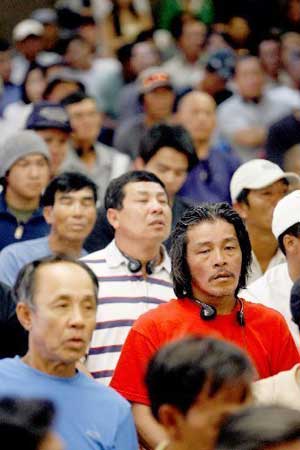
Mary Queen of Vietnam Development Corporation
In 1975, after the fall of Saigon, many of the Christian Vietnamese who supported the U.S.-allied government in the south fled. Some ended up in camps in the Midwestern U.S., at least until the Archdiocese of New Orleans invited them to come to the Gulf of Mexico, where the climate was more like what they were used to in Vietnam. Many of the Vietnamese were also fisherman, so the Roman Catholic church thought they’d have a better chance if they could pick up their old trade in Louisiana.
Now, almost 40 years later, there are 8,000 Vietnamese concentrated in a one-mile radius in New Orleans East. The community of fisherman was hit hard by Hurricane Katrina, and then the Deepwater Horizon debacle, but found ways to come together. At a recent EPA conference on repurposing industrial areas, or brownfields, Tap Bui, a community organizer at the Mary Queen of Vietnam Community Development Corporation, discussed how this unique community recovered with sustainable aquaponics.
New Orleans East has 60 percent of the land mass of New Orleans but only 20 percent of its population. Before Katrina, there were high levels of poverty and unemployment. As the community fled the storm in late August, 2005, many residents wondered what they would come back to, Bui says. The storm destroyed the community’s hospital and other basic services. Still, by the end of October, more than 2,000 people had returned, and the majority of residents eventually came back.
Meanwhile, implementing an “emergency master plan,” then-Mayor Ray Nagin turned a green space near their community into a landfill. The debris from damaged homes and commercial buildings across New Orleans had to be dumped somewhere. But soon pesticides and other chemicals were being dumped there, too, near a wetland and nature preserve. According to Bui, this spurred one of the first “cross-racial” collaborations ever in New Orleans East, a mass protest to shut down the landfill.

NOLAMary Queen of Vietnam community meeting.
“We rallied outside city hall,” Bui says. The group also bused in protestors to Baton Rouge, the state capitol. This was the first time “we Vietnamese actually felt like real Americans,” she says. “Before, we had just paid our taxes. Our community had become more engaged.”
Their efforts paid off: The landfill was closed, and more than 200,000 cubic yards of debris were removed. But still more needs to go. “The landfill is slowly sinking into the ground. The dump site is affecting the wetlands,” says Bui. Environmental remediation work is ongoing.
Then, Deepwater Horizon, the BP offshore oil spill, struck, which was a fishing disaster. Bui says 40,000 Vietnamese work in the Gulf of Mexico, and a third of those are in the seafood industry. Particularly for the older Vietnamese, Bui says, it’s really a case of “I fish, therefore I am.” More Vietnamese were suffering from depression and drinking too much.
In a sign of the truly resilient nature of the Vietnamese community in New Orleans East, the community once again rallied. “We did power mapping to determine how we were going to make BP pay for what they did to the Gulf,” Bui says. The Vietnamese joined together once again with a broader coalition of seafood industry groups to pressure the oil company. But while the Gulf was being restored, the fishermen had to find new jobs, immediately.
The development corporation found a trainer who could teach aquaculture, the practice of raising fish on land. A two-day session brought up new ways to create more sustainable systems. In a pilot phase, workshop attendees tested out growing koi, bluefish, and catfish. Some then experimented with “aquaponics,” which uses the waste from fish as fertilizer to grow produce.

USDA
Now, the VEGGI Farmer’s Cooperative, a massively scaled-up aquaponics operation for the community, sells fresh produce to local restaurants and stores.
Amazingly, the fishermen who lost their livelihoods to the oil spill have “supplemented 100 percent of their earlier incomes,” Bui says. Taking out marketing and transportation costs, some “80 cents of each dollar goes back to the cooperative members,” she says.
Now, aquaponics plots have spread from backyard to backyard. Also, the group has finally been able to lease a 4-acre site, where a 2-acre farm is now under development. As this community sees urban farming as the way forward, expect to see VEGGI products in your next great meal in New Orleans.




